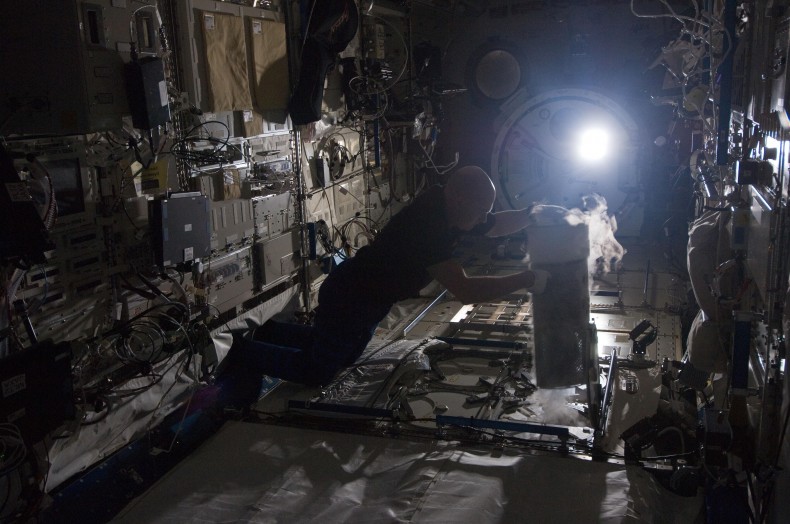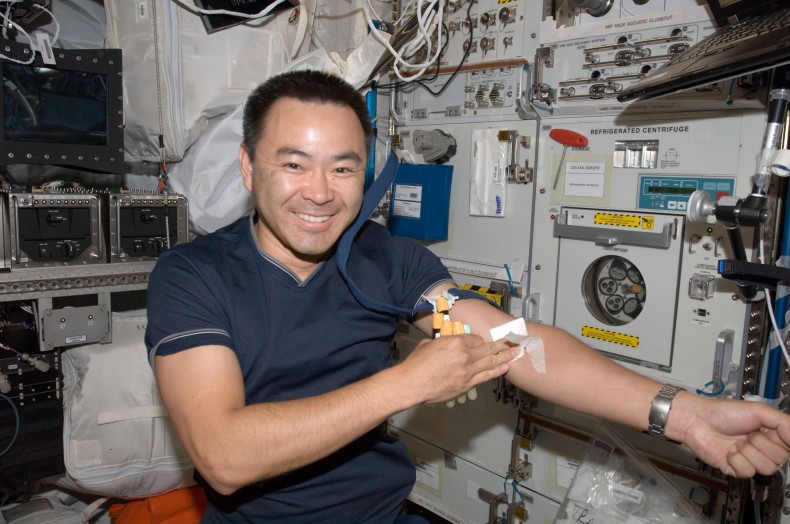 The manned craft negotiates entry into the thin Martian atmosphere and lands in some sort of ingenious fashion in the three-eighths gravity. This is it. My generation’s very own “One small step for a human” moment. Real live people are inside, ready to hop out and get to work. The fifteen-minutes-delayed camera feed zooms in on the door, which opens,
The manned craft negotiates entry into the thin Martian atmosphere and lands in some sort of ingenious fashion in the three-eighths gravity. This is it. My generation’s very own “One small step for a human” moment. Real live people are inside, ready to hop out and get to work. The fifteen-minutes-delayed camera feed zooms in on the door, which opens,
…the door opens, I said.
…hang on, where is she?
Oh there she is, lying like a useless lump in her seat, smiling weakly.
“Recovery, anecdotally, it’s day for day,” says former astronaut Michael Lopez-Alegria, who spent 215 straight days on the ISS. “So for a seven-month mission, it takes the same amount of time to feel normal.”
When you first return to gravity, your blood volume is 10% lower than normal, and your vestibular system has become uncoupled from gravity, so you walk around like a drunk person for a day or two. You might be able to drive again after about two weeks, but pervasive fatigue lasts a long time — months. When the first humans arrive in the partial gravity of Mars, they won’t be bursting out of their spacecraft ready to explore. It may require months of recovery before they are able to work. We’ve learned a lot about health in space, but there remain some major unknowns for a manned mission to Mars.
Fourteen years of continuous presence in the International Space Station, as well as the work of cosmonauts in the Mir Station before it, rapidly assessed the most immediate health issues of life without gravity and in many cases dealt with them entirely. Early experience in zero gravity showed that without resistance training, not only did muscle tone atrophy, but bones became brittle and porous like those of osteoporosis sufferers. Back on Earth, the exterior cortex of the bone builds back, but the inside does not.
Present day astronauts have much less to worry about on this front. Two or three hours of physio per day lets them return to Earth with little detectable bone loss. The next step will be to work up a more elegant design for their exercise equipment. “The current ISS resistance device for bone density is the size of a car,” says W. H. Paloski, Director of NASA’s Space Life and Physical Sciences division “For a Mars mission it will have to be the size of a shoe box.”
In some ways, though, the ISS can’t tell us what Mars pioneers would have to deal with, because it’s not clear which health problems will level out into a steady state, which will worsen cumulatively and which will appear only after a longer space flight duration. For example, until ISS crew started conducting 90-day missions they never noticed the visual impairments that come with cerebrospinal fluid drift. With no gravity to keep it down, the fluid raises intracranial pressure. The optic nerve swells, then the retina becomes engorged with fluid and the entire eyeball flattens.
To make matters worse, the ISS has a high CO2 level in its air supply, which also increases blood flow to the head. Astronauts now expect to switch to new glasses mid-mission. So far, the problem has resolved itself on the ground and hasn’t significantly affected functionality in orbit, but we don’t know whether longer holidays from gravity would lead to more severe or permanent changes.
 The standard ISS mission is between one and three months. One-year missions will begin soon, with one American and one Russian astronaut volunteering for the first long-haul shifts.
The standard ISS mission is between one and three months. One-year missions will begin soon, with one American and one Russian astronaut volunteering for the first long-haul shifts.
ISS astronauts have medical training to a standard a little lower than what a typical paramedic might receive. But truly self-reliant remote medical care, including zero-G surgery, will involve much more sophisticated knowledge and ingenuity. The top emergency evacuation conditions are kidney stones, sepsis, stroke and hip fractures. Practicing CPR in space, astronauts found they had to go into an enclosed space and brace their feet against the ceiling to work up the pressure needed for chest compressions.
As for the microgravity of Mars, we just don’t know what to expect. We can’t just assume the same zero-G health issues will simply exist to a lesser degree. Too often, in space, things don’t play out according to our intuitions. The only safe assumption, for now, is that partial gravity gives no protection at all.
Altered gravity fields mess with the greatest range of physiological systems — immune, musculoskeletal, digestive — but for cumulative risk the big worry is radiation. Our atmosphere shields us from the worst of deep space radiation, and without it we’re subject to nasty assaults on our body tissue. Cataracts have long been recognized as a produce of excessive UV exposure, but the kind of radiation exposure in space will lead to degenerative and chronic conditions like heart disease as well as the long-term risk of cancer. Acute radiation sickness up there would be on the order of persistent anemia and non-specific (prodromal) symptoms.
It’s not realistic to build into spacecraft design the kind of buffer thicknesses we’d need for adequate protection. But in the meantime federal radiation safety limits cap exposure at a 3% greater risk of developing cancer later in life. Any mission to Mars will far outstrip that risk. To compete with private industry NASA is looking at raising those limits, on the understanding that astronauts already accept high personal risks for societal benefit.
The psychological impact of a trip to Mars goes beyond the bleak prospect of never returning. Even the journey to swing around Mars and come back — such as that proposed by the Inspiration Mars team — would be an experience far removed, psychologically, from a stay of similar length on the space station.
ISS crew can contact friends and family almost any time of day and access email instantaneously. They can see their home planet in large, spectacular technicolour right out the window. On Mars, it’ll take 15 minutes or so to get any response from Earth. En route, it will be daytime all the time. Travelers won’t even see stars. Outside the window, there will just be blackness. Utter blackness.
Images: NASA
One thought on “Astronaut, Heal Thyself”
Comments are closed.